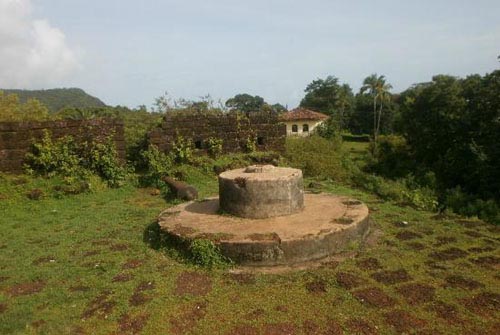Cabo de Rama Fort

Information on Cabo de Rama Fort (Goa) - History & Architecture
The fort Cabo de Rama is located in Goan beach. The fort is named after the Hindu God Lord Rama. The fort is specifically located in the Canacona district of Goa. It is positioned at 25 km to the southern end of the Margao region. While talking about this historical fort, it contains huge importance when it comes to history of Goa as well as the importance it has shaped the Goa and the days that was once ruled by the Portuguese.
Cabo de Rama Fort Architecture
The fort has the fusion of Indian and Portuguese architectural style. There is a church named Santo Antonio is positioned inside the Cabo de Rama Fort which is still being used by the local residents for worshipping. Most part of the fort including the church is well preserved till date. The contrasting colour of the fort i.e. black and the church i.e. white provide a magnificent architectural view for the tourists. The fort is erected in a way that people can see a panoramic view of the Colva beach along with the Canacona stretch. The place also provides a mystical atmosphere for the visitors which are an experience of some kind. Notably, the western end of the monument provides an empirical northern and southern end of the sea. The rusty cannons used by the Portuguese during their rule in the fort can also be seen in the place till date. There is also a small sculpture of Virgin Mary can be found within the fort. There is a well along two springs in the fort that provides cold and hot water respectively. The fort is basically made with the help stones and mud.
Cabo de Rama Fort History
The monument i.e. Cabo de Rama is one of the oldest fort in the history of Goa. The fort was mainly erected and designed with the arrival of the Portuguese in rule in Goa in between the period of 17th-18th century. One of the most interesting historical facts about the fort is that it is one of the places where lord Rama stayed with wife Sita during their 14 years of exile. Though the fort was owned by the Portuguese during its early days, it was overtaken by the Hindu rulers in the year 1763. The rulers made several changes in the fort including the removal of many cannons of the Portuguese. By the year 1955, the bastion house within the monument was converted into a prison. In the later stages, the fort was used by young scientists of National Institute of Oceanography to carry out scientific research. The fort is positioned in the National Highway of Karwar. A historical record suggests that prior to the rule of the Portuguese in the fort it was used as a residence by the Raja of Sonda in the year 1763. In course of its existence, the British troops also used the fort as their military base roughly in the year 1900s.
Cabo de Rama Fort Tourism Importance
The fort is located in the outskirts of the city where one cannot find too much of sounds and gathering of the town. It offers a silent atmosphere for the visitors who can have a good time in the fort in their leisure time. However, in the absence of proper transport and communication between the fort and the city, it is recommended that personal transport will be the appropriate choice to reach the place. The visitors can also witness the scenic beauty of the sea from the fort. These factors will certainly influence tourist to visit the fort once when pay a visit to Goa.
- Andaman Nicobar Monuments
- Andhra Pradesh Monuments
- Assam Monuments
- Bihar Monuments
- Chhattisgarh Monuments
- New Delhi Monuments
- Goa Monuments
- Gujarat Monuments
- Haryana Monuments
- Himachal Pradesh Monuments
- Jammu and Kashmir Monuments
- Karnataka Monuments
- Kerala Monuments
- Madhya Pradesh Monuments
- Maharashtra Monuments
- Odisha Monuments
- Punjab Monuments
- Rajasthan Monuments
- Tamil Nadu Monuments
- Telangana Monuments
- Uttar Pradesh Monuments
- West Bengal Monuments